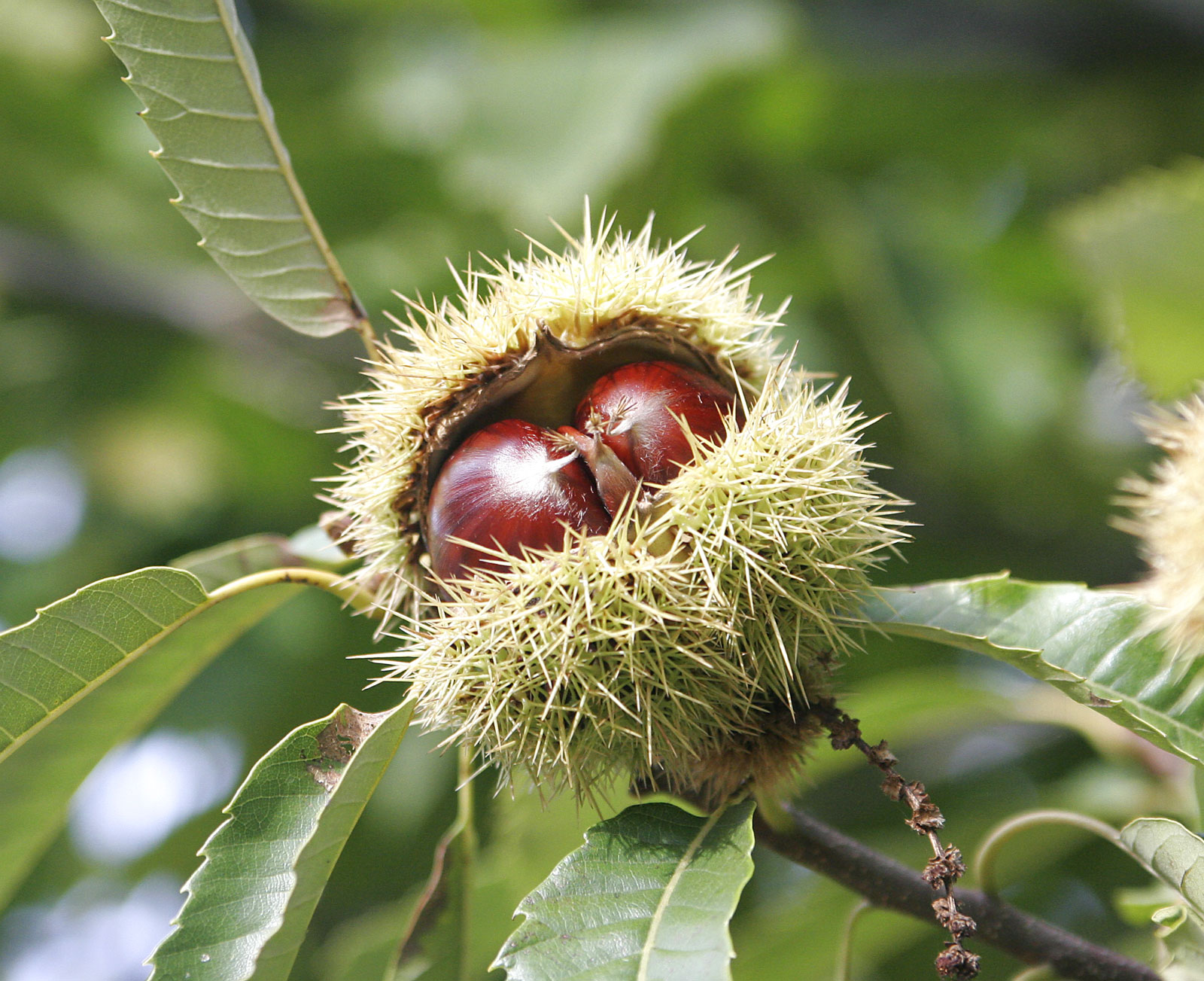- Sweet Chestnut
Taxobox
name = Sweet Chestnut

image_width = 250px
image_caption = Sweet Chestnut fruit
regnum =Plant ae
divisio = Magnoliophyta
classis = Magnoliopsida
ordo =Fagales
familia =Fagaceae
genus = "Castanea"
species = "C. sativa"
binomial = "Castanea sativa"
binomial_authority = Mill.The Sweet Chestnut ("Castanea sativa", family
Fagaceae ), also known as the Spanish Chestnut, Portuguese Chestnut or European chestnut, is a species ofchestnut originally native to southeasternEurope andAsia Minor . It is a medium-sized to largedeciduous tree attaining a height of 20-35 m with a trunk often 2 m in diameter. The oblong-lanceolate, boldly toothed leaves are 16-28 cm long and 5-9 cm broad.The
flower s of both sexes are borne in 10-20 cm long, upright catkins, the male flowers in the upper part and female flowers in the lower part. They appear in late June to July, and by autumn, the female flowers develop into spinycupule s containing 3-7 brownish nuts that are shed during October. Some species ("Marron de Lyon, Paragon' and some hybrids) produce only 1 large nut, rather than the average 2 to 4 nuts of edible size.The bark often has a net-shaped (retiform) pattern with deep furrows or fissures running spirally in both directions up the trunk.
The tree requires a mild climate and adequate moisture for good growth and a good nut harvest. Its year-growth (but not the rest of the tree)“Plants For A Future” (PFAF http://www.pfaf.org/database/plants.php?Castanea+sativa and book.] is sensitive to late spring and early autumn frosts, and is intolerant of lime. Under forest conditions it will tolerate moderate shade well.
Uses
Sweet Chestnut is widely cultivated for its edible
seed s, also callednut s. As early as Roman times it was introduced into more northerly regions, and later was also cultivated in monastery gardens by monks. Today, centuries-old specimens may be found inGreat Britain and the whole of central, western and southernEurope . They are widely popular inTurkey ,Portugal ,France ,Hungary ,Italy ,Croatia , Bosnia and particularly inCorsica .The raw nuts, with their pithy skin around the seed, are somewhat astringent. That skin can be relatively easily removed by quickly blanching the nuts after having made a cross slit at the tufted end.http://hedgewizardsdiary.blogspot.com/2006/10/peeling-chestnuts-easy-way-chestnuts.html an easy way of peeling the pellicle, or pithy skin.] Once cooked they become delicious, developing, when roasted, a sweet flavour and floury texture not unlike sweet potato. The cooked nuts can be used by confectioners, puddings, desserts and cakes or eaten roasted. They are used for flour, bread making, a cereal substitute, coffee substitute, a thickener in soups and other cookery uses, as well as for fattening stock. A sugar can be extracted from it. The Corsican variety of
polenta (called pulenta) is made with sweet chestnut flour. A local variety of Corsican beer also uses chestnuts. An easy way for peeling them is given here.Leaves infusions are used in respiratory diseases and are a popular remedy for whooping cough. It is much used in
homeopathy and in Bach remedies for which the key words are 'Extreme mental anguish', 'Hopelessness' and 'Despair'.P. M. Chancellor. Handbook of the Bach Flower Remedies. C. W. Daniel Co. Ltd. 1985 ISBN 85207 002 0. Details the 38 remedies and their prescriptions.] A hair shampoo can be made from ifusing leaves and fruit husks.This tree responds very well to coppicing, which was commonly practiced until fairly recently in Britain, and produces a good crop of
tannin -rich wood every ten years or so. The tannin renders the young growing wood durable and resistant to outdoor use, thus very suitable for posts, fencing or stakes.Oleg Polunin. Trees and Bushes of Britain and Europe. Ed Paladin, 1973, pp. 51, 188 and 195).] The wood is of light colour, hard and strong. It is also used to make furniture, barrels (sometimes used to agebalsamic vinegar ), and roof beams notably in southern Europe (for example in houses of the Alpujarra, Spain, in southern France and elsewhere). Due to older wood's tendency to split and warp badly, and acquiring a certain brittleness, it is not frequently used in large pieces. It is also a very good fuel.Tannin is found in the following proportions on a 10% moisture basis:bark (6.8%), wood (13.4%), seed husks (10 - 13%). The leaves also contain tannin.A tree grown from seed may take twenty years or more before it bears fruits, but a grafted species such as "Marron de Lyon" or "Paragon" may start production within five years of being planted. Both the latter species bear fruits with a single large kernel, rather than an average of two to four smaller kernels.
Gallery
ee also
*
American chestnut
*Chinese chestnut
*Recalcitrant seed References
* [http://rbg-web2.rbge.org.uk/cgi-bin/nph-readbtree.pl/feout?FAMILY_XREF=&GENUS_XREF=Castanea&SPECIES_XREF=sativa&TAXON_NAME_XREF=&RANK= Flora Europaea: "Castanea sativa"]
*Rushforth, K. (1999). "Trees of Britain and Europe". HarperCollins ISBN 0-00-220013-9.
*http://www.fao.org/DOCREP/006/AD235E/ad235e00.htm#Contents
*http://cesonoma.ucdavis.edu/hortic/pdf/chestnut_99.pdf
Wikimedia Foundation. 2010.
